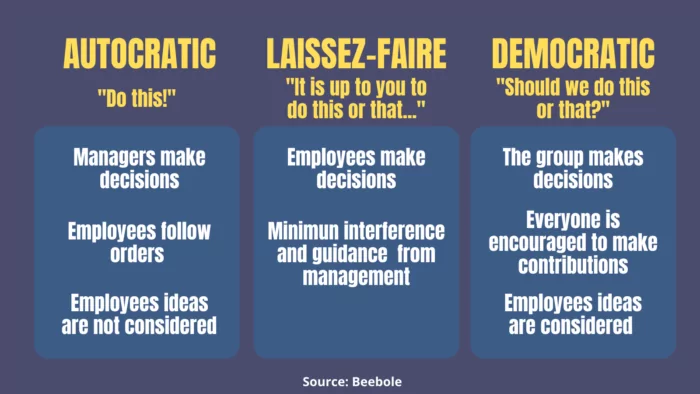Why democratic leadership is the best style to boost productivity


What does good leadership mean in the era of hybrid and remote work? What kind of leadership style is best to keep productivity high and promote an ethical workforce? As the title of this article suggests, we may have a straightforward answer for you. However, it might not be so simple—stay tuned for the twist at the end of this article!
But before we get there, let’s review a few key leadership concepts.
In his well-known article “Understanding leadership,” Professor William C. H. Prentice provides one of the most compelling definitions: “Leadership is the accomplishment of a goal through the direction of human assistants—a human and social achievement that stems from the leader’s understanding of his or her fellow workers and the relationship of their individual goals to the group’s aim.”
Even though the above definition was coined in 1961, its relevance remains intact. In fact, the fundamentals of leadership haven’t changed that much. According to Ron Ashkenas and Brook Manville, coauthors of the “Harvard Business Review Leader’s Handbook,” leadership is still about “mobilizing people in an organization around common goals to achieve impact, at scale.”
While there are various types of leadership classifications, we would like to stick to the classic (and still relevant) models conceived by Professor Kurt Lewin during the 1930s. Lewin and his fellow researchers identified the following three main leadership styles.
As its name suggests, the autocratic leadership style is when one individual makes all the decisions without taking into consideration input from other people in the group. Because of that, there is little room for employee ideas and contributions in the autocratic leadership style. In fact, employees are supposed to follow orders. While this approach may sound negative, the autocratic style offers some advantages, especially in terms of the decision making process. Decisions are made fast by the most experienced people, and clear guidance is given to employees through instructions, tasks, and goals.
In the laissez-faire or free-rein leadership style, employees are the ones in charge of making decisions. In fact, in this style, management’s role is limited to setting goals and providing assistance in case of need.
While this approach empowers employees, it could backfire. This is especially true if the members of the group don’t have the necessary skills and/or experience to make decisions. Similarly, the lack of guidance can provoke communication confusion and problems.
Just like a democracy, this leadership style gives everyone a voice. Everybody is encouraged to participate in the decision process. Unlike the autocratic model, this leadership model encourages their employees to make contributions and bring new ideas to the table.
Thanks to this approach, employees feel empowered and motivated to make a contribution to the organization. This is something that can have a positive impact on job satisfaction, commitment, and productivity.
The democratic leadership style is also different from the laissez-faire model in terms of the guidance it provides. With democratic leadership, you can expect a strong leader who not only leads and promotes a consultative decision process, but also has the authority to make final decisions. That’s why the democratic leadership style offers some advantages over the other two styles, especially when it comes to managing hybrid and remote teams. Let’s explore this leadership style in more detail.

Democratic leadership is a type of leadership model where the members of a group are actively encouraged to participate in the decision making process of a company. It makes sense, then, that this type of leadership style is also known as participative leadership or shared leadership. Let’s take a look at the main elements of this style.
In his 1994 article “A Definition and Illustration of Democratic Leadership,” John Gastill, Distinguished Professor at Penn State University, defines democratic leadership as the performance of the following three core functions:
These core functions are guided by a set of principles in which decisions are made on the basis of consensus, and relationships are built on mutual respect and collaboration. Likewise, shared responsibility is supported by delegation and regular consultation.
According to author Kendra Cherry, democratic leadership works best in situations that have the following two conditions:
Considering the decision-making process is in the hands of the group, it is essential that group members are experienced enough to make significant, valuable contributions to the process. If that’s not the case, adopting a democratic leadership style may lead to stagnation.
It’s also key that group members are eager to participate in the decision process and cooperate with their colleagues. Members should also be committed to their group’s goals, even when their ideas are rejected. Because of this, it is important to consider whether or not the team has the necessary traits to allow them to succeed under a participative approach. Note that it’s important to keep these traits in mind when defining your recruiting process or bringing new people into your organization.
Considering all of the above, “private companies, educational institutions and nonprofit organizations in expansion mode are well-suited for the democratic/participative leadership style because it encourages collaboration. Participatory leadership rewards success and fosters a collegial environment,” states an article published by Saint Thomas University.
Likewise, the democratic leadership style is also suitable for very specific circumstances. These include introducing operational changes, encouraging team building, or fixing complex issues that require significant input from different players throughout the organization.
Yashi Srivastava, leadership coach for BetterUp, argues that “there are certain scenarios that offer a great place to practice democratic leadership.” Some of these scenarios include the following:
Having a strong leader is one of the most important elements of the democratic leadership style. In fact, being a good democratic leader is something that requires strong values and skills. In terms of values, Cherry reminds us that good democratic leaders possess specific traits such as honesty, intelligence, courage, creativity, competence, and fairness. Because of that, “strong democratic leaders inspire trust and respect among followers,“ argues Cherry.
As far as skills and traits go, democratic leaders are very rational, focused, and great at multitasking. Additionally, they’re great at motivating their teams. More democratic leadership skills include:
Now that we know the democratic leadership model’s main elements, let’s look at the pros and cons:

As you can see, the democratic leadership style has its downsides. However, this style can provide significant benefits for our newly remote/hybrid world, especially in terms of productivity. Let’s see why.
Happy employees work better and produce more. Far from being a cliché, this statement has already been proven true many times. In fact, a paper entitled Happiness and Productivity, which was based on different experiments carried out by scholars from the University of Warwick, concluded that happiness made people around 12% more productive. Why is this relevant to the democratic leadership style?
Because democratic leadership is based on a set of principles that allow companies to create robust cultures. When you empower people to be part of the decision making process, you are fostering engagement among your workforce. This ultimately leads to a high level of job satisfaction and yes, happiness.
If you combine that with a good level of guidance and support (another feature of the democratic leadership style), your team’s productivity will be positively affected. As noted by Professor Andrew J Oswald, one of the scholars who produced the “Happiness and Productivity” paper, “companies like Google have invested more in employee support, and employee satisfaction has risen as a result. For Google, it rose by 37%, they know what they are talking about. Under scientifically controlled conditions, making workers happier really pays off.”
Besides the engagement and collaborative approach that comes with a democratic leadership style, the figure of a leader who “de-emphasized social distance” (borrowing the words from organizational psychologist Bernard M. Bass) helps a lot in terms of the support and empathy that remote workers expect from their managers.
Considering that communication, loneliness, and fatigue are some of the biggest challenges of managing a remote workforce, having a leader who is egalitarian by nature and is willing to roll up his or her sleeves for the group quickly relays both support and empathy to staff. In fact, this level of support and empathy is more naturally aligned with a democratic leader than an autocratic one.
According to an article written by Barbara Z. Larson, Susan R. Vroman, and Erin E. Makarius, the very first step that managers can take without great effort to improve the engagement and productivity of remote employees is that of understanding their needs and challenges. Because of this, having a leader who is naturally empathetic goes a long way in terms of productivity.
Parallel to all this, the current hybrid/remote working conditions are a natural match for the participative leadership style. Frank Weishaupt, CEO of the tech company Owl Labs, argues that this new environment, where in-person meetings are no longer the rule, has provided more opportunities to collaborate and participate in the decision process.
“While conference calls or video meetings can have a team member leading or a designated host in presenter mode, it’s easier for someone else to swiftly take the floor and bring their ideas to the virtual table, giving more opportunities for meaningful discussion and idea sharing. These collaborative opportunities are invaluable to leadership, due to the outpouring of organic and free-flowing dialogue, where they are able to hear from their teams, firsthand,” says Weishaupt.
Along those lines, democratic leadership provides a good base for some of the best hybrid and remote work strategies that companies are using nowadays to boost engagement and productivity. “Executives and HR teams are always looking at ways to make business practices more inclusive, from hiring to promotions; it’s time we make conversations democratized through hybrid meetings. This more open style of collaboration enables team members with different work styles, personality types, and communication preferences to have their voices heard equally,” concludes Weishaupt.
Adopting a democratic leadership style is likely the most effective way to deal with the current hybrid/remote work environment.
But we also believe that today’s leadership needs to be flexible in a way it was never necessary before. It’s more important than ever before to adapt to meet particular circumstances or needs, even if that means shifting in leadership styles.
Believe it or not, this is far from revolutionary. When Abraham Lincoln was dealing with the abolition of slavery, he wanted to reach consensus using a democratic leadership approach. However, when he realized that reaching such consensus was impossible, he made his decision and announced it to his team. “An arguably authoritative, yet effective, move,” states Srivastava.
There is no doubt that a democratic style is the best fit for today’s workplace. However, keeping a flexible approach to leadership is a winning factor in a world that is moving faster than ever. As stated by author and psychologist Priyanka Prashob, “The best leadership style is to keep adapting yourself to meet the situation and your people’s needs. Ultimately, it all boils down to keeping your people happy, engaged, and motivated. Because if you do this, productivity will be taken care of by itself!”
—
Photo by LinkedIn Sales Solutions on Unsplash
We are entering a new era where remote and hybrid-based models will likely prevail across the corporate world. Because of this, remote work options will surely increase and even become dominant for many companies. But can a remote or hybrid company still be a great place to work? Can you keep your remote employees engaged, […]
In The CFO Journal we share insights and advice from Chief Financial Officers and other financial leaders from diverse industries and backgrounds. In this installment, Eurobits Technologies CFO Sergio Sánchez shares what it’s like to be a leader in a highly regulated and rapidly evolving industry such as Open Banking. Who is Sergio Sánchez? Where: […]
Welcome to The Great Resignation Era. Staff turnover is global. Is your organization really prepared with a retention strategy? Find out.